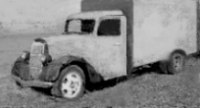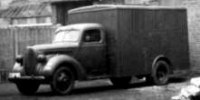 |
| Opel Blitz |
The
RSHA office II D 3a was responsible for construction, employment, drivers and the provision of spare parts
for the gas vans. During WW2 two types were used: small versions with about 3.5t payload for about 50
persons (
Diamond,
Opel Blitz, and
Renault) and bigger ones with approximately 5t payload
for around 70 victims (
Saurer). The wagons had an air-sealed car-body and looked like furniture vans.
With a removable tube the exhaust fumes could be led into the car body. A barred lamp could be used to illuminate
the interior.
SS-Obersturmbannführer
Walter Rauff was in charge of all
Gestapo vehicles, including gas vans.
Rauff (chief of section II D3., Technical Service of the Sipo) ordered
SS-Hauptsturmführer Friedrich Pradel (section II D3., chief of the
Technical Service of the
Reichskriminalpolizeiamt) and
Harry Wentritt
(section II D3.a, chief of the repair shop of the
Reichskriminalpolizeiamt) to visit the
Gaubschat Fahrzeugwerke GmbH,
Willi-Walter Straße 32-38, Berlin.
This company produced superstructures for lorries and buses. At the factory both men pretended, that the vans
would be used to transport the corpses of epidemic victims. The chassis (probably
Renault) were to be
delivered by the RSHA. Ultimately the complete delivery failed and the RSHA could not fulfil the intended
supply and only delivered 5 or 6 chassis [2 February 1961, StA Hannover, Az. 2 Js 299/60 / Zentrale Stelle
Ludwigsburg, Az. 415 AR-Z 220/59, Bl.260b]. However, according to
Pradel’s statements, about 20 gas vans had been delivered by
23 June 1942 out of the initial 30 vans ordered from
Gaubschat.
Rauff proposed certain amendments to the remaining 10 vehicles,
but
Gaubschat said it was unable to carry out these alterations because of a lack of labour and materials.
Consideration was given to diverting the order to the firm of
Sodomka at
Hohenmauth (Vysoké Mýto, Czech Republik), but was discarded since
Sodomka was a Czech firm in a Czech area with a Czech workforce and was thus believed to constitute a
security risk. In the event, only one of the 10 remaining vehicles was modified by
Gaubschat.
Pradel reported:
"
Those alterations that Gaubschat cannot make because of their
secret nature will be done in our own shop.” The vans were finally changed to gas vans at
Wentritt's KTI repair shop.
According to
www.zwangsarbeits-forschung.de
Jewish forced labourers were imprisoned in the factory complex.
Prior to gassing, the victims were ordered to hand over their valuables. They then had to undress and finally
entered the gas vans. The two doors at the back of the wagons were
closed, and the tube then locked to the exhaust. To calm down the naked victims a lamp was switched on for some minutes.
The driver then started the motor, which ran in neutral gear for about ten minutes. During this time the motor
produced enough carbon monoxide to suffocate the victims. As they were so crowded together there was
lack of air anyway. When the screaming and pounding had stopped, the driver started the drive to the cremation site.
There Jewish men, who would not be permitted to remain alive, were forced to unload the corpses and cremate them.
Sometimes the victims were gassed at the site of their mass grave; e.g. in
Stalino where on
Easter Monday 1942
200 - 300 Jews were killed in gas vans and their corpses pushed into the shaft of a coal mine.
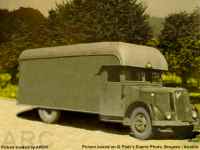 |
| Saurer |
 |
| Gas Trailer |
Gas vans were used on a large scale by the
Einsatzgruppen in Byelorussia and the Ukraine.
Here thousands of persons, mainly Jews, were killed by the use of these wagons. For example,
thousands of Jews from the
Minsk Ghetto lost their lives in gas vans which were
stationed at the extermination site
Maly Trostinec, 12 km southwest of
Minsk.
Eberhard von Thadden, a Foreign Office official who succeeded
Franz Rademacher as head of the Jewish desk, noted in his diary a visit by
representatives of the Italian Fascist Party to
Generalkommissar Wilhelm Kube
in
Minsk on
15 May 1943.
Kube showed the visitors a church that was being used as a warehouse. The
diary entry continues:
"
The Italians asked about the little packages and suitcases that were
piled up in the church. Kube explained that this was
all that was left of the Jews who had been deported from Minsk.
Then he showed them a gas chamber in which he said Jews had been gassed. The Fascists were severely
shaken."
At least 152,000 people were gassed by the use of gas vans at the
Chelmno extermination camp near
Lodz.
In addition there were also experimental trials at the
Belzec extermination camp.
SS-Oberscharführer
Lorenz Hackenholt and
Siegfried
Graetschus, under the supervision of
Christian Wirth, converted a grey painted Post Office
parcels delivery van into a mobile gassing van.
In the internment camp
Sajmiste (Semlin) at
Zemun
on the Danube 6,280 Jews were killed by a special command using gas vans.
The well-known photos of the
Magirus van which was found in
Kolo (near
Chelmno) after the war, probably do not show a gas van.
See this correspondence:
Enquires on the Killing of the Gombin Jews
Leon Zamosc
Date:
25 August 1995
Subject: Gas vans,
Chelmno
From:
Leon Zamosc
I am trying to find a photograph or any other graphic illustration of the gas vans used at
Chelmno and other places. Has anyone seen anything in books or elsewhere?
I am also interested in pictures of the
Chelmno camp.
Will welcome any reference.
Leon Zamosc
University of California,
San Diego
lzamosc@weber.ucsd.edu
Date:
11 October 1995
Subject: Re: Gas vans in
Chelmno
From:
Jerzy Halbersztadt
Dr.
Leon Zamosc was interested few weeks ago in finding a graphic illustration
of the gas vans used at
Chelmno.
I made some survey (with an assistance of
Marek Jannasz) and here are the results:
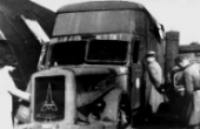 |
| Magirus Wreck #1 |
 |
| Magirus Wreck #2 |
The case of
Chelmno death camp was investigated by the Main Commission for the
Investigation of German Crimes in Poland (it was the commission's name at the beginning of it's existence)
starting from
May 1945. The commission
received the information that in the town
KOLO (ca. 12 km from
Chelmno) in the former factory of
Ostrowski
there was a van which, according to the witnesses, was used in the death center at
Chelmno. The van was found, photographed and researched.
The photos taken then are available in the Main Commission's Archives in
Warsaw
(signatures 47398, 47396, 47397, 47399; the best one is 47398). The captions of these photographs are till today:
"a car for killing people by the exhaust fumes at
Chelmno". One of these photos
was reproduced in
Fleming's book "Hitler and the Final Solution" with the
information that it is a photograph of a "gaswagon" used in
Chelmno.
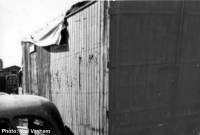 |
| Magirus Wreck #3 |
 |
| Magirus Wreck #4 |
Despite of their captions, the photographs do not show the gas van used in the
Chelmno death camp.
It is clear from the testimonies of Polish witnesses kept in the same archives of the Main Commission
(collection "Ob", file 271 and others). Witnesses to whom the van photographed in
Kolo was shown did not confirm that it was one of those used in
Chelmno for killing people. Some of them only said that it was
similar to those described in their testimonies, but not the same. The most common answer was:
"I didn't see this one".
The inspection of the van in
Ostrowski factory, done on
13 November 1945
by the judge
J.Bronowski, did not confirm the existence of any elements of
system of gassing of the van's closed platform. The witnesses called this van "a pantechnicon van" (a van to
transport furniture). It was produced by
Magirus-Werke with a diesel type engine of
Deutz. The plate
on the engine stated:
Humboldt-Deutz A.G. Magirus-Werke
Ulm (Donau) Baujahr
1939 Lieferdat 739 Abn-Stempel.
Fahrgestell Nr. 9282/38 Nutzlast kg 2700 Fahrgestell-Baumuster 023. Eigengewicht 4980 kg. Motor Baumuster FoM 513 zul.
Gesamtgew. 7900 Leistung P.S. 105 cm
3 7412. Zulässige Achsendrücke vorn kg 2400 hinten 5500."
The thickness of the car's wooden body was 7 cm, of the door - 8 cm. The walls, door, ceiling and floor were
covered from the inside with the 2 mm sheet iron. The car was painted in grey- lead color. Under this
paint the inscription was seen on the door of the cab:
Otto Koehn Spedition Ruf 516
Zeulen .....da i.TH".
I cite all these details to make possible the further comments to the story of this van. It is my feeling that there
are some unclear points in this story. Nobody explained for what purpose this van was used? Its door
was tightened with an impregnated canvas. What for? Some witnesses had seen this car in the area of the
forest of
Chelmno starting from the
spring of 1942.
It is possible that it belonged to the
SS-Sonderkommando Kulmhof, too.
I came across a version that this van was used for a disinfection of victims' clothes but there are no grounds for it.
In
1945 the prosecutors came to the conclusion that this van was not a gas van of
Chelmno. The van was left incomplete and not serviceable in
Ostrowski's
factory at least till
1950. The last known documents (a correspondence between the
Association of Combatants "ZBoWiD" in
Kolo and the Main Commission)
of
April 1950 inform that there was an idea to move this van to the museum in
Auschwitz or
Majdanek.
(till
1990 there was no museum in the
Chelmno forest;
first monument was erected there in
1964). Those plans were not accomplished and the
van was scrapped, probably.
Thus, there is no reliable graphic illustration of the gas vans used in
Chelmno.
However, the testimonies of witnesses contain many important data on these vehicles. In
1945
and later Polish authorities examined some Poles who stayed in the area of
Chelmno
after the removal of the vast majority of the Polish population to the GG in
1939-1940.
The witnesses were able to identify gas vans very well. They declared that there were three or four gas vans, one of
them was a bit bigger. All of them were black. The cars' bodies were boxes made of boards. The length of a biggest
vehicle was 5.5-6 m. It was ca. 2.5 m high and 2.5 m wide. Each vehicle was guarded all the time
(even during the repair in the local factories) by two watchmen, who did not give anybody the access to the van and,
especially, to the chassis and the closed box (platform).
However, at least three witnesses were able to see the vehicles from the short distance. Mr.
Jozef Piaskowski (b.
1908) was employed in the
Reichsstraßenbauamt in
Kolo (former
Ostrowski factory). In the
winter 1941/42 he was ordered to repair the damaged cooler in the biggest of
Chelmno vans.
Piaskowski
was an experienced driver. He declared later that he has never seen the motor of this type. "The motor
was a bit odd". "It was enormous". The most interesting in his report is the description of the exhaust system.
He has noticed that the exhaust pipe was divided into three parts. First and third were done of metal as in
normal cars. But, the central part was done of the elastic, "hydraulic" pipe which could joint both standard
tubes or could be screwed to the holen the van's floor. After the repair of the cooler, when the motor was
tested, so much exhaust fumes were produced that the air in the garage (size 30 m x 12 m) started immediately
to be blue. The German bosses ordered to open all windows and doors. The workers who spent a very short
time in the polluted air have got headache. The witness heard later their comments that the motor of this car
uses 75 liters of petrol per 100 km, so twice more than normal motors do.
Piaskowski
stated that he had seen two military type gas-masks in the driver's cab.
Piaskowski's
colleague, Mr.
Bronislaw Mankowski (b.
1882),
confirmed his story and added that he had seen the van when the middle part of the exhaust tube was joint to the
hole in the car's floor.
Mankowski declared that he looked inside the box when
the watchmen left their posts for a while. He had seen a hole covered with a perforated sheet iron in the middle of
the wooden floor.
Another witness, Mr.
Bronislaw Falborski (b.
1910),
was employed in the
Kraft company in
Kolo where the
vehicles of the
SS-Sonderkommando Kulmhof were repaired starting from
1942. In
the
summer of 1942 he received
the order to repair one of the gas vans. His description of the exhaust pipe is in general the same as done by
witnesses cited above. The only (but important) difference is the description of the connection of elastic pipe
with the hole in the car's floor. According to
Falborski (who made even a picture)
they were joint by two fasteners tightened by four screws. It seems that this connection was permanent, quite difficult
to change and only optionally substituted by the standard connection of both metal parts of the exhaust pipe as
in normal cars.
Falborski's report seems reliable as his task was to make this
connection air-tight by the change of the packing between two fasteners.
The cases of the repair of gas vans in the local workshops of
Kolo seem to be
rare and exceptional. Probably it happened only in necessity when it was impossible to use military - or
SS-motor services.
The
Chelmno death center stopped to operate many months before the liberation
of this site. The gas vans were very easy to move from the area of
Chelmno-Kolo
and to change into standard vans with very little signs of their previous function. It is very difficult to think
that SS murders (who tried to destroy all evidences of genocide, like crematoria, camps, corpses, etc.) could
simply forget a gas van near to
Chelmno or elsewhere.
Jerzy Halbersztadt
University of Warsaw and US Holocaust Museum, Washington, DC.
, and gas trailer are not original. They
just show their possible appearance.
Kogon, Eugen; Langbein, Hermann; Rückerl, Adalbert; eds.








